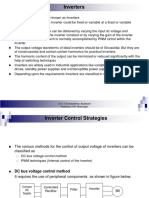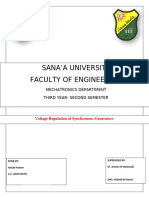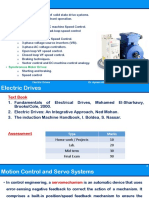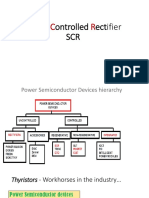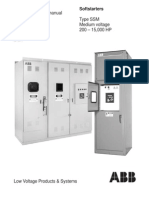Chapter 3: Electric Drives and Converters Feeding Electric Motors
Uploaded by
Selemon AssefaChapter 3: Electric Drives and Converters Feeding Electric Motors
Uploaded by
Selemon AssefaAmbo university ECE 3282
AMBO UNIVERSITY
INSTITUTE OF TECHNOLOGY
DEPARTMENT OF ELECTRICAL AND COMPUTER ENGINEERING
Electrical Machines
Chapter 3: Electric Drives and Converters feeding Electric Motors
Introduction to electric drives, Torque production in electric drives, Types of load torques,
Basic elements of electric drives, Dynamics of motor-load combination, Determination of referred
load-torque and moment of inertia. Converters of Feeding Electric Motors: Rectifier circuits,
Choppers, PWM –Inverters
Electric Drives:
Motion control is required in large number of industrial and domestic applications like
transportation systems, rolling mills, paper machines, textile mills, machine tools, fans, pumps, robots,
washing machines etc.
Systems employed for motion control are called DRIVES, and may employ any of prime movers
such as diesel or petrol engines, gas or steam turbines, steam engines, hydraulic motors and electric
motors, for supplying mechanical energy for motion control Drives employing electric motors are
known as ELECTRICAL DRIVES.
An ELECTRIC DRIVE can be defined as an electromechanical device for converting electrical
energy into mechanical energy to impart motion to different machines and mechanisms for various kinds
of process control.
Basic elements of Electric Drive System:
Block diagram of an electric drive system is shown in the figure below.
A modem variable speed electrical drive system has the following components
Electrical machines and loads
Power Modulator
Sources
Control unit
Sensing unit
Electrical Machines
Most commonly used electrical machines for speed control applications are the following
2014 GC Electrical Machines
Ambo university ECE 3282
DC Machines
Shunt, series, compound, separately excited DC motors and switched reluctance machines.
AC Machines
Induction, wound rotor, synchronous, PM synchronous and synchronous reluctance machines.
Special Machines
Brush less DC motors, stepper motors, switched reluctance motors are used.
Power Modulators Functions:
Modulates flow of power from the source to the motor in such a manner that motor is imparted
speed-torque characteristics required by the load During transient operation, such as starting, braking
and speed reversal, it restricts source and motor currents with in permissible limits. It converts electrical
energy of the source in the form of suitable to the motor Selects the mode of operation of the motor (i.e.)
Motoring and Braking.
Types of Power Modulators
In the electric drive system, the power modulators can be any one of the following
Controlled rectifiers (ac to dc converters)
Inverters (dc to ac converters)
AC voltage controllers (AC to AC conveners)
DC choppers (DC to DC conveners)
Cyclo conveners (Frequency conversion)
Electrical Sources
Very low power drives are generally fed from single phase sources. Rest of the drives is powered
from a 3 phase source. Low and medium power motors are fed from a 400v supply. For higher ratings,
motors may be rated at 3.3KV, 6.6KV and 11 KV. Some drives are powered from battery.
Sensing Unit
Speed Sensing (From Motor)
Torque Sensing
Position Sensing
Current sensing and Voltage Sensing from Lines or from motor terminals From Load
Temperature Sensing
Control Unit
Control unit for a power modulator are provided in the control unit. It matches the motor and
power convener to meet the load requirements.
Classification of Electric Drives
According to Mode of Operation
Continuous duty drives
Short time duty drives
Intermittent duty drives
2014 GC Electrical Machines
Ambo university ECE 3282
According to Means of Control
Manual
Semi-automatic
Automatic
According to Number of machines
Group Electric Drive:
This drive consists of a single motor, which drives one or more line shafts supported on bearings.
The line shaft may be fitted with either pulleys and belts or gears, by means of which a group of
machines or mechanisms may be operated. It is also sometimes called as SHAFT DRIVES.
Advantages
A single large motor can be used instead of number of small motors
Disadvantages
There is no flexibility. If the single motor used develops fault, the whole process will be stopped.
Individual Electric Drive:
In this drive each individual machine is driven by a separate motor. This motor also imparts
motion to various parts of the machine.
Multi Motor Electric Drive:
In this drive system, there are several drives, each of which serves to actuate one of the working
parts of the drive mechanisms.
E.g.: Complicated metal cutting machine tools
Paper making industries.
Rolling machines etc.
According to Dynamics and Transients
Uncontrolled Transient period
Controlled transient period
According to Methods of Speed Control
Reversible and non-reversible uncontrolled constant speed.
Reversible and non-reversible step speed control.
Variable position control.
Reversible and non-reversible smooth speed control.
Advantages of Electrical Drive:
1. They have flexible control characteristics. The steady state and dynamic characteristics of electric
drives can be shaped to satisfy the load requirements.
2. Drives can be provided with automatic fault detection systems. Programmable logic controller and
computers can be employed to automatically control the drive operations in a desired sequence.
3. They are available in wide range of torque, speed and power.
4. They are adaptable to almost any operating conditions such as explosive and radioactive
environments
5. It can operate in all the four quadrants of speed-torque plane
2014 GC Electrical Machines
Ambo university ECE 3282
6. They can be started instantly and can immediately be fully loaded
7. Control gear requirement for speed control, stalling and braking is usually simple and easy to
operate.
Choice (or) Selection of Electrical Drives
Choice of an electric drive depends on a number of factors. Some of the important factors are.
1. Steady State Operating conditions requirements
Nature of speed torque characteristics, speed regulation, speed range, efficiency, duty cycle,
quadrants of operation, speed fluctuations if any. ratings etc
2. Transient operation requirements
Values of acceleration and deceleration, starting, braking and reversing performance.
3. Requirements related to the source
Types of source and its capacity, magnitude of voltage, voltage fluctuations, power factor,
harmonics and their effect on other loads, ability to accept regenerative power
4. Capital and running cost, maintenance needs life.
5. Space and weight restriction if any.
6. Environment and location.
7. Reliability.
Dynamics of Motor Load System:
Fundamentals of Torque Equations
A motor generally drives a load (Machines) through some transmission system. While motor
always rotates, the load may rotate or undergo a translational motion.
Load speed may be different from that of motor, and if the load has many parts, their speed may be
different and while some parts rotate others may go through a translational motion. Equivalent rotational
system of motor and load is shown in the figure.
Notations Used:
J = Moment of inertia of motor load system referred to the motor shaft kg - m2
ωm= Instantaneous angular velocity of motor shaft, rad/sec.
T = Instantaneous value of developed motor torque. N-m
Ti = Instantaneous value of load torque, referred to the motor shaft N-m
Load torque includes friction and wind age torque of motor. Motor-load system shown in figure can be
described by the following fundamental torque equation.
Equation (1) is applicable to variable inertia drives such as mine winders, reel drives. Industrial robots.
2014 GC Electrical Machines
Ambo university ECE 3282
For drives with constant inertia
Equation (2) shows That Torque developed by motor is counter balanced by load torque Ti and a
Dynamic torque
Torque component is called dynamic torque because it is present only during
The transient operations.
Note:
Energy associated with dynamic torque is stored in the form of kinetic energy
given by
Classification of Load Torques:
Various load torques can be classified into broad categories.
Active load torques
Passive load torques
Load torques which has the potential to drive the motor under equilibrium conditions are called active
load torques. Such load torques usually retain their sign when the drive rotation is changed (reversed)
Eg:
Torque due to force of gravity
Torque due tension
Torque due to compression and torsion etc
Load Torques which always oppose the motion and change their sign on the reversal of motion are
called passive load torques
Eg:
Torque due to friction, cutting etc.
Components of Load Torques:
The load torque Ti can be further divided in to following components
(i) Friction Torque (TF)
Friction will be present at the motor shaft and also in various parts of the load. TF is the equivalent value
of various friction torques referred to the motor shaft.
(ii) Windage Torque (Tw)
2014 GC Electrical Machines
Ambo university ECE 3282
When motor runs, wind generates a torque opposing the motion. This is known as windage torque.
(iii) Torque required to do useful mechanical work.
Nature of this torque depends upon particular application. It may be constant and independent of speed.
It may be some function of speed, it may be time invariant or time variant, its nature may also change
with the load's mode of operation.
Converters of Feeding Electric Motors:
BASIC RECTIFIER CIRCUITS:
A rectifier circuit is a circuit that converts ac power to dc power. There are many different
rectifier circuits which produce varying degrees of smoothing in their dc output.
1. The half-wave rectifier
2. The full-wave bridge rectifier
The Half-Wave Rectifier:
A half-wave rectifier is shown in Figure 3-16a, and its output is shown in Figure 3-16b. The diode
conducts on the positive half-cycle and blocks current flow on
The negative half-cycle. A simple half-wave rectifier of
this sort is an extremely poor approximation to a constant
dc waveform—it contains ac frequency components at 60 Hz and its entire harmonics. A half-wave
rectifier such as the one shown has a ripple factor r = 121 percent, which means it has more ac voltage
components in its output than dc voltage components. Clearly, the half-wave rectifier is a very poor way
to produce a dc voltage from an ac source.
The Full-Wave Rectifier:
.
Full-wave rectifier circuit is shown in
Figure 3-17b. In this circuit, diode D1,
conducts on the positive half-cycle of the
ac input with the current returning
through the center tap of the transformer,
and diode D2 conducts on the negative
half-cycle of the ac input with the current
returning through the center tap of the
transformer. The output waveform is
identical to the one shown in Figure 3-
17c.
2014 GC Electrical Machines
Ambo university ECE 3282
A good measure of the smoothness of the dc voltage out of a rectifier circuit is the ripple factor
of the dc output. The percentage of ripple in a dc power supply is defined as the ratio of the rms value of
the ac components in the supply's voltage to the dc value of the voltage
Where Vac,rms is the rms value of the ac components of the output voltage and VDC is the dc
component of voltage in the output. The smaller the ripple factor in a power supply, the smoother the
resulting dc waveform.
The dc component of the output voltage VDC is quite easy to calculate, since it is just the average
of the output voltage of the rectifier:
The rms value of the ac part of the output voltage is harder to calculate, though, Since the dc
component of the voltage must be subtracted first. However, the ripple factor r can be calculated from a
different but equivalent formula which does not require the rms value of the ac component of the
voltage. This formula for ripple is
Where Vrms is the rms value of the total output voltage from the rectifier and Vdc is the dc or
average output voltage from the rectifier.
DC-TO-DC POWER CONTROL-CHOPPERS:
Sometimes it is desirable to vary the voltage available from a dc source before applying it to a
load. The circuits which vary the voltage of a dc source are called dc-to-dc converters or choppers. In a
chopper circuit, the input voltage is a constant dc voltage source, and the output voltage is varied by
varying the fraction of the time that the dc source is connected to its load. Figure 3-39 shows the basic
principle of a chopper circuit. When the SCR is triggered, it turns on and power is supplied to the load.
When it turns off, the dc source is disconnected from the load.
In the circuit shown in Figure 3-39, the load is a resistor, and the voltage on the load is either VDC or 0-
Similarly, the current in the load is either VDC/R . It is possible to smooth out the load voltage and
current by adding a series inductor to filter out some of the ac components in the waveform. Figure 3-40
shows a chopper circuit with an inductive filter. The current through the inductor increases
exponentially when the SCR is on and decreases exponentially when the SCR is off. If the inductor is
2014 GC Electrical Machines
Ambo university ECE 3282
large, the time constant of the current changes (T = L/R) will be long relative to the on/off cycle of the
SCR and the load voltage and current will be almost constant at some average value.
2014 GC Electrical Machines
Ambo university ECE 3282
2014 GC Electrical Machines
Ambo university ECE 3282
In the case of ac phase controllers, the SCRs automatically turn off at the end of each half-cycle
when their currents go to zero. For dc circuits, there is no point at which the current naturally falls below
IH, so once an SCR is turned on, it never turns off. To turn the SCR off again at the end of a pulse, it is
necessary to apply a reverse voltage to it for a short time. This reverse voltage stops the current flow
and turns off the SCR. Once it is off, it will not turn on again until another pulse enters the gate of the
SCR. The process of forcing an SCR to turn off at a desired time is known as forced commutation.
GTO thyristors are ideally suited for use in chopper circuits, since they are self-commutating. In
contrast to SCRs, GTOs can be turned off by a negative current pulse applied to their gates. Therefore,
the extra circuitry needed in an SCR
Chopper circuit to turn off the SCR can be eliminated from a GTO thyristor chopper circuit.
Power transistors are also self-commutating and are used in chopper circuits that fall within their power
limits.
Chopper circuits are used with dc power systems to vary the speed of dc motors. Their greatest
advantage for dc speed control compared to conventional methods is that they are more efficient than the
systems.
INVERTERS:
Perhaps the most rapidly growing area in modern power electronics is static frequency
conversion, the conversion of ac power at one frequency to ac power at another frequency by means of
solid-state electronics. Traditionally there have been two approaches to static ac frequency conversion:
the cycloconverter and the rectifier-inverter.
The cycloconverter is a device for directly converting ac power at one frequency to ac power at
another frequency, while the rectifier-inverter first converts ac power to dc power and then converts the
dc power to ac power again at a different frequency.
An inverter to produce ac power from the dc power.
Pulse-Width Modulation Inverters:
Pulse-width modulation is the process of
modifying the width of the pulses in a pulse train in
direct proportion to a small control signal; the greater the
control voltage, the wider the resulting pulses become.
By using a sinusoid of the desired frequency as the
control voltage for a PWM circuit, it is possible to
produce a high-power waveform whose average voltage
varies sinusoidally in a manner suitable for driving ac
motors.
The basic concepts of pulse-width modulation
are illustrated in Figure 3-55a. Shows a single-phase PWM
inverter circuit using IGBTs. The states of IGBT1, through
IGBT4 in this circuit.
2014 GC Electrical Machines
Ambo university ECE 3282
The operation of the Inverter can be summarized as:
1. When T1 and T4 are "on" while T3 and T2 are "off”: + voltage is obtained in load
2. When T3 and T2 are "on" while T1 and T4 are "off”: - Voltage is obtained in load
Assume that a sinusoidal control voltage is applied to the circuit as shown in Figure 3-58. The
width of the resulting pulse train varies sinusoidally with the control voltage. The result is a high-power
output waveform whose average voltage over any small region is directly proportional to the average
voltage of the control signal in that region. The fundamental frequency of the output waveform is the
same as the frequency of the input control voltage. Of course, there are harmonic components in the
output voltage, but they are not usually a concern in motor-control applications.
A complete three-phase PWM inverter would consist of three of the single-phase inverters
described above with control voltages consisting of sinusoids shifted by 120° between phases.
Frequency control in a PWM inverter of this sort is accomplished by changing the frequency of the
input control voltage.
2014 GC Electrical Machines
You might also like
- Simulation of Some Power System, Control System and Power Electronics Case Studies Using Matlab and PowerWorld SimulatorFrom EverandSimulation of Some Power System, Control System and Power Electronics Case Studies Using Matlab and PowerWorld SimulatorNo ratings yet
- A Case Study for a Single-Phase Inverter Photovoltaic System of a Three-Bedroom Apartment Located in Alexandria, Egypt: building industry, #0From EverandA Case Study for a Single-Phase Inverter Photovoltaic System of a Three-Bedroom Apartment Located in Alexandria, Egypt: building industry, #0No ratings yet
- Unit V Design of Controllers For Drives: 3.1transfer Function For DC MotorNo ratings yetUnit V Design of Controllers For Drives: 3.1transfer Function For DC Motor12 pages
- 25-Feb-2020 11B Converter Fed and Chopper Fed DC DrivesNo ratings yet25-Feb-2020 11B Converter Fed and Chopper Fed DC Drives16 pages
- Electric Machines Lab: Open Ended Lab ReportNo ratings yetElectric Machines Lab: Open Ended Lab Report8 pages
- Experiment No. 1 Transfer Function of Two Phase A. C. Servo MotorNo ratings yetExperiment No. 1 Transfer Function of Two Phase A. C. Servo Motor3 pages
- V and Inverted V Curves of Synchronous MotorNo ratings yetV and Inverted V Curves of Synchronous Motor4 pages
- 2. Voltage Regulation of Synchronous GeneratorsNo ratings yet2. Voltage Regulation of Synchronous Generators8 pages
- Ac Voltage Controller Using Thyristor Project Report by Sandeep100% (1)Ac Voltage Controller Using Thyristor Project Report by Sandeep29 pages
- Magnetic Amplifier in Series: Operation ManualNo ratings yetMagnetic Amplifier in Series: Operation Manual6 pages
- Singly-Excited and Doubly Excited SystemsNo ratings yetSingly-Excited and Doubly Excited Systems4 pages
- Experiment 4 - EE 308 Flyback ConverterNo ratings yetExperiment 4 - EE 308 Flyback Converter19 pages
- DC Motor Speed Control by Four Quadrant ChopperNo ratings yetDC Motor Speed Control by Four Quadrant Chopper12 pages
- Applications of Power Electronics To Power SystemsNo ratings yetApplications of Power Electronics To Power Systems8 pages
- Clap Switch Circuit Electronic Project Using 555 Timer100% (1)Clap Switch Circuit Electronic Project Using 555 Timer2 pages
- P.F. & P.F Improvement of Using CapacitorNo ratings yetP.F. & P.F Improvement of Using Capacitor3 pages
- Unit Iii Induction Motor Drives: Dept. of EEENo ratings yetUnit Iii Induction Motor Drives: Dept. of EEE17 pages
- Sensorless Control of Permanent Magnet Synchronous Machine Drives - 2023 - Zhu - Front MatterNo ratings yetSensorless Control of Permanent Magnet Synchronous Machine Drives - 2023 - Zhu - Front Matter35 pages
- Zero Power Factor or Potier Triangle Method 7100% (1)Zero Power Factor or Potier Triangle Method 73 pages
- FDP On Electric Vehicles by Manipal University JaipurNo ratings yetFDP On Electric Vehicles by Manipal University Jaipur2 pages
- Chapter 1 - Introduction To Machinery Principles PDFNo ratings yetChapter 1 - Introduction To Machinery Principles PDF27 pages
- Elements of Electric Drive Systems: Mohamed A. El-Sharkawi University of Washington Seattle, WA 98195No ratings yetElements of Electric Drive Systems: Mohamed A. El-Sharkawi University of Washington Seattle, WA 9819534 pages
- PSA - Lecture 6 - Symmetrical Fault Analysis (Part-1)No ratings yetPSA - Lecture 6 - Symmetrical Fault Analysis (Part-1)43 pages
- Experiment 12 The Universal Motor ObjectiveNo ratings yetExperiment 12 The Universal Motor Objective5 pages
- Introduction To Engineering Materials:: - Materials Science Is An Applied ScienceNo ratings yetIntroduction To Engineering Materials:: - Materials Science Is An Applied Science30 pages
- Experiment 1 Resistors: A. Background BackgroundNo ratings yetExperiment 1 Resistors: A. Background Background8 pages
- Site Visit Report On Excavator: Section 1 I100% (1)Site Visit Report On Excavator: Section 1 I2 pages
- Exercise 1. Find Element and Global Stiffness For The Following Spring. A)No ratings yetExercise 1. Find Element and Global Stiffness For The Following Spring. A)5 pages
- Design of Adjustable Wheel Removal TrolleyNo ratings yetDesign of Adjustable Wheel Removal Trolley3 pages
- FPSC Assistant Executive Engineer (Electrical) 02 Aug, 2019No ratings yetFPSC Assistant Executive Engineer (Electrical) 02 Aug, 201910 pages
- Power Electronics Lab Assignment-I: Resistor Capacitive (RC) Triggering Circuit (Half Wave) of SCRNo ratings yetPower Electronics Lab Assignment-I: Resistor Capacitive (RC) Triggering Circuit (Half Wave) of SCR9 pages
- Industrial Electronics Assignment #2 Silicon Controlled Switch (SCS)No ratings yetIndustrial Electronics Assignment #2 Silicon Controlled Switch (SCS)8 pages
- SPR3 EN TCD210147AB Modi 20211008 CATALOG WNo ratings yetSPR3 EN TCD210147AB Modi 20211008 CATALOG W2 pages
- Power Electronics Converters Applications: November 2023No ratings yetPower Electronics Converters Applications: November 202341 pages
- CH 3 - Controlled Rectifiers (Autosaved)No ratings yetCH 3 - Controlled Rectifiers (Autosaved)39 pages
- What Is GTO - Types, Construction, Working and ApplicationsNo ratings yetWhat Is GTO - Types, Construction, Working and Applications22 pages
- EXP 1-Charecteristics of SCR, MOSFET & IGBT-finalNo ratings yetEXP 1-Charecteristics of SCR, MOSFET & IGBT-final12 pages
- 4el01: Power Electronics CREDITS - 3 (LTP: 3,0,0)No ratings yet4el01: Power Electronics CREDITS - 3 (LTP: 3,0,0)2 pages
- 6 Single-Phase Controlled Rectifiers PDFNo ratings yet6 Single-Phase Controlled Rectifiers PDF22 pages
- Be Electronics and Telecommunication Engineering Semester 6 2024 March Power Devices and Circuits Pd c Pattern 2019No ratings yetBe Electronics and Telecommunication Engineering Semester 6 2024 March Power Devices and Circuits Pd c Pattern 20192 pages
- Simulation of Some Power System, Control System and Power Electronics Case Studies Using Matlab and PowerWorld SimulatorFrom EverandSimulation of Some Power System, Control System and Power Electronics Case Studies Using Matlab and PowerWorld Simulator
- A Case Study for a Single-Phase Inverter Photovoltaic System of a Three-Bedroom Apartment Located in Alexandria, Egypt: building industry, #0From EverandA Case Study for a Single-Phase Inverter Photovoltaic System of a Three-Bedroom Apartment Located in Alexandria, Egypt: building industry, #0
- Unit V Design of Controllers For Drives: 3.1transfer Function For DC MotorUnit V Design of Controllers For Drives: 3.1transfer Function For DC Motor
- 25-Feb-2020 11B Converter Fed and Chopper Fed DC Drives25-Feb-2020 11B Converter Fed and Chopper Fed DC Drives
- Experiment No. 1 Transfer Function of Two Phase A. C. Servo MotorExperiment No. 1 Transfer Function of Two Phase A. C. Servo Motor
- Ac Voltage Controller Using Thyristor Project Report by SandeepAc Voltage Controller Using Thyristor Project Report by Sandeep
- Applications of Power Electronics To Power SystemsApplications of Power Electronics To Power Systems
- Clap Switch Circuit Electronic Project Using 555 TimerClap Switch Circuit Electronic Project Using 555 Timer
- Sensorless Control of Permanent Magnet Synchronous Machine Drives - 2023 - Zhu - Front MatterSensorless Control of Permanent Magnet Synchronous Machine Drives - 2023 - Zhu - Front Matter
- FDP On Electric Vehicles by Manipal University JaipurFDP On Electric Vehicles by Manipal University Jaipur
- Chapter 1 - Introduction To Machinery Principles PDFChapter 1 - Introduction To Machinery Principles PDF
- Elements of Electric Drive Systems: Mohamed A. El-Sharkawi University of Washington Seattle, WA 98195Elements of Electric Drive Systems: Mohamed A. El-Sharkawi University of Washington Seattle, WA 98195
- PSA - Lecture 6 - Symmetrical Fault Analysis (Part-1)PSA - Lecture 6 - Symmetrical Fault Analysis (Part-1)
- Computer Aided Design of Electrical MachinesFrom EverandComputer Aided Design of Electrical Machines
- Power System Wide-area Stability Analysis and ControlFrom EverandPower System Wide-area Stability Analysis and Control
- Introduction To Engineering Materials:: - Materials Science Is An Applied ScienceIntroduction To Engineering Materials:: - Materials Science Is An Applied Science
- Exercise 1. Find Element and Global Stiffness For The Following Spring. A)Exercise 1. Find Element and Global Stiffness For The Following Spring. A)
- FPSC Assistant Executive Engineer (Electrical) 02 Aug, 2019FPSC Assistant Executive Engineer (Electrical) 02 Aug, 2019
- Power Electronics Lab Assignment-I: Resistor Capacitive (RC) Triggering Circuit (Half Wave) of SCRPower Electronics Lab Assignment-I: Resistor Capacitive (RC) Triggering Circuit (Half Wave) of SCR
- Industrial Electronics Assignment #2 Silicon Controlled Switch (SCS)Industrial Electronics Assignment #2 Silicon Controlled Switch (SCS)
- Power Electronics Converters Applications: November 2023Power Electronics Converters Applications: November 2023
- What Is GTO - Types, Construction, Working and ApplicationsWhat Is GTO - Types, Construction, Working and Applications
- Be Electronics and Telecommunication Engineering Semester 6 2024 March Power Devices and Circuits Pd c Pattern 2019Be Electronics and Telecommunication Engineering Semester 6 2024 March Power Devices and Circuits Pd c Pattern 2019





